Optimizing SEO Content with NLP: A Content Strategy with NEURONwriter
Search engines now focus on context and intent, not just keywords, making it harder to rank without a clear strategy. Natural Language Processing (NLP) takes SEO to the next level by helping your content match what people are really searching for.
What is NLP in SEO?
NLP is a type of artificial intelligence that helps computers understand human language. It analyzes words, context, and relationships to determine meaning.
In SEO, NLP is used to understand user intent behind search queries. This means Google and other search engines can match results more accurately to what people are looking for. Instead of just focusing on exact keywords, NLP focuses on the context and purpose of the search.
For example, if someone searches “ways to keep a room cool without air conditioning,” search engines understand the user is looking for practical solutions like fans, insulation, or cooling techniques.

Search engines use Natural Language Processing to break down web content into elements like headings, keywords, and entities. This process helps them assess how well a page covers a topic and if it answers user queries effectively.
For content creators, using these insights allows them to align their pages with what users are searching for. This means structuring content clearly, using relevant terms, and ensuring it meets specific search intent. When done right, this increases the chances of higher rankings and better engagement.
How Does NLP Work in SEO?
Search engines use NLP to process and analyze large volume of texts by breaking it into smaller parts like words or sentences. They rely on this to identify patterns and better understand the meaning of queries and content.
Here’s how it works in steps:
Breaking Text into Pieces
The first step is tokenization. This means breaking text into smaller parts like words or sentences. This helps search engines process the information more easily and look for patterns.
Simplifying Words
Next is stemming and lemmatization. This process reduces words to their simplest forms. For example, “running” becomes “run.” This ensures all variations of a word are understood in the same context.
Identifying Key Topics
NLP recognizes entities like names, dates, or specific places in the text. This helps search engines focus on the main topics or subjects in a query or webpage.
Understanding Relationships
Search engines then analyze how words connect in a sentence. This step, called dependency parsing, helps them understand the structure and meaning of the content.
Finding Deeper Meaning
Semantic analysis looks at the bigger picture. It considers synonyms, sentence structure, and context to grasp the intent behind the text. This ensures search engines deliver results based on what the user is really looking for.
Applying Advanced Models
Google uses BERT (Bidirectional Encoder Representations from Transformers) to make this process smarter. Models like these understand language in a more natural way, even when queries are worded differently.
Why is NLP Important for SEO Today?
NLP is changing how content connects with what people are searching for. People no longer type short keywords. Instead, they ask full questions or use conversational language. Without NLP, search engines would struggle to understand these queries, making it harder for your content to rank.
Ten years ago, someone might search “best phones 2014,” and search engines would match those exact words. Today, a user might ask, “What is the best phone for photography?” NLP uses machine learning to understand the intent behind the question. It knows the user is looking for phones with great cameras, not general reviews. This shift in algorithms has made intent-focused content a key part of any effective SEO strategy.
NLP also helps you stand out in a competitive space. The algorithm now prioritizes meaning and intent over keyword repetition. High-quality content that addresses user needs is more likely to rank. Relying on keywords alone no longer works. Using NLP allows you to create content that aligns with user expectations and improves your SEO.
It enhances content creation by analyzing context, structure, and semantic relevance. This makes your content more valuable to users and easier for search engines to match with the right queries. In a world where competition for visibility is tough, NLP is essential for a winning SEO strategy.
How is SEO with NLP different from the traditional SEO
Traditional SEO relied heavily on keywords and technical elements. It focused on matching exact phrases to search queries. This often led to keyword stuffing and generic content that lacked depth. Search engines would rank pages based on how many times a keyword appeared, rather than how well the content answered the query.
Before NLP SEO, traditional SEO did not analyze relationships between words. It also struggled with conversational queries or natural language searches. NLP identifies connections and understands how terms relate to each other. This helps search engines rank content that provides a complete answer. It also means pages with broader, well-structured information perform better.
What Tools Can Help with NLP SEO Optimization?
Proper content optimization for SEO using NLP doesn’t need to be complicated. You don’t need a lot of tools for that and NEURONwriter does most of the heavy lifting making SEO a lot easier.
For our how-to I will only use NEURONwriter and Google Search Console. I am not using any paid keyword research tool.
How-To Optimize SEO using NLP with NEURONwriter
Analyse the page you want to improve in Google Search Console (GSC)
I am using a page that I have improved using NEURONwriter. as you can see in 3 months time from April 1st to end of June I received 1.29k clicks. I sorted the table by impressions to see which top query I wanted to optimize for. Optimise pages that have some good history in GSC so you can see what kind of keywords you are ranking for.
Based on this I chose alpha bravo charlie

Adding query in NEURONwriter
In your projects click the New Query button.
In the Dialogue Window click on Optimize Content. Add in the URL and the query you want to optimize. So where I found the query in GSC, I add it in there. Make sure to select the country or city which you want to target. This makes sense if you do it for local SEO.
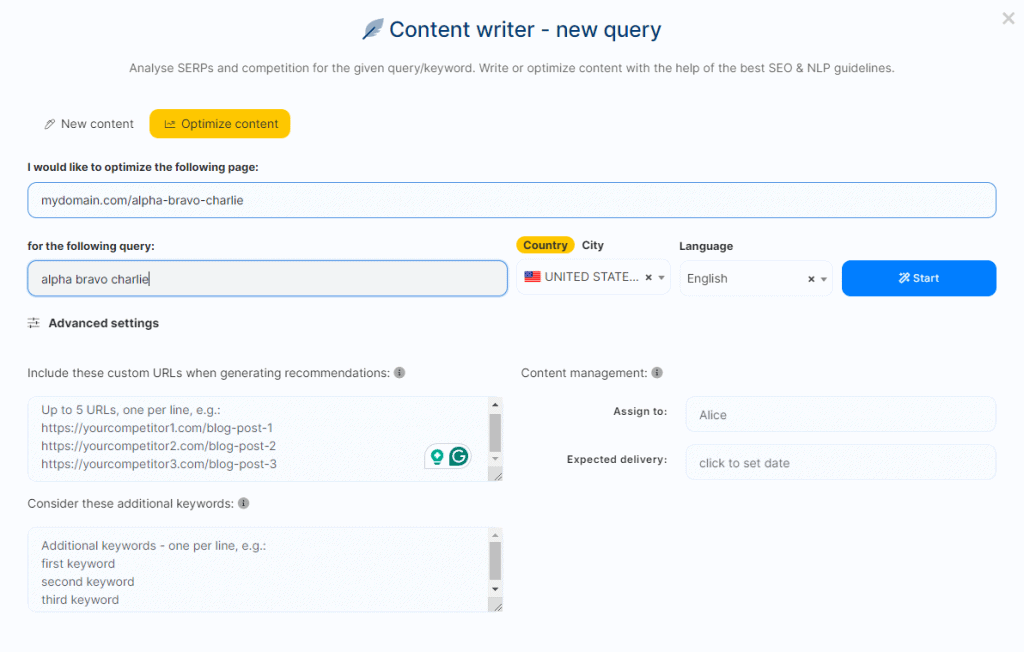
In the Advanced Settings add in competitors if you know them. A quick search in Google for the same keyword could show you the competitors on top. But NEURONwriter also does that for you after the analysis.
Also handy is you can add additional keywords to consider.
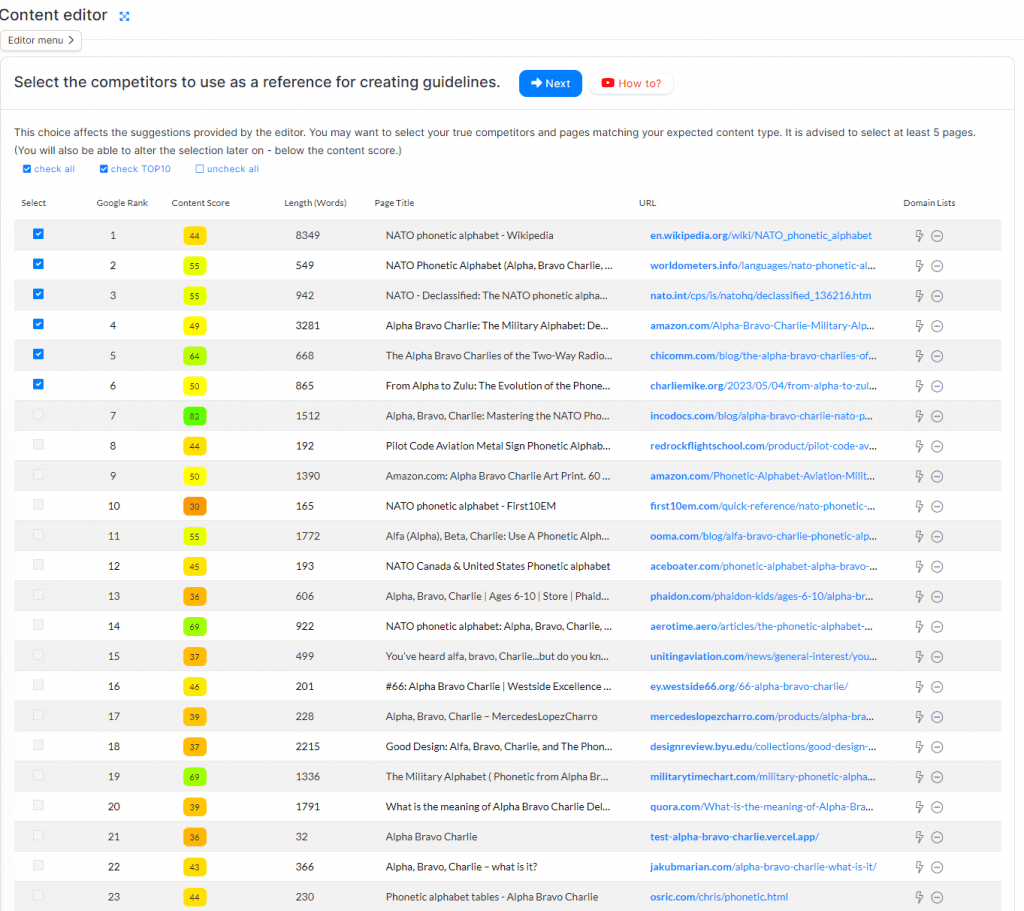
After the analysis is complete, NEURONwriter shows the top 30 search results for the specific query you want to improve and selected by default the top 10.
You should be selecting the competitors that fulfil the same intent as your article. This way you will use the NLP terms in a similar way how the best performing do it in Google. Click Next when you are done.
In the next dialogue, you can either copy and paste in your own content or use the auto-import feature. Either way make sure the SEO title, Meta description are also in
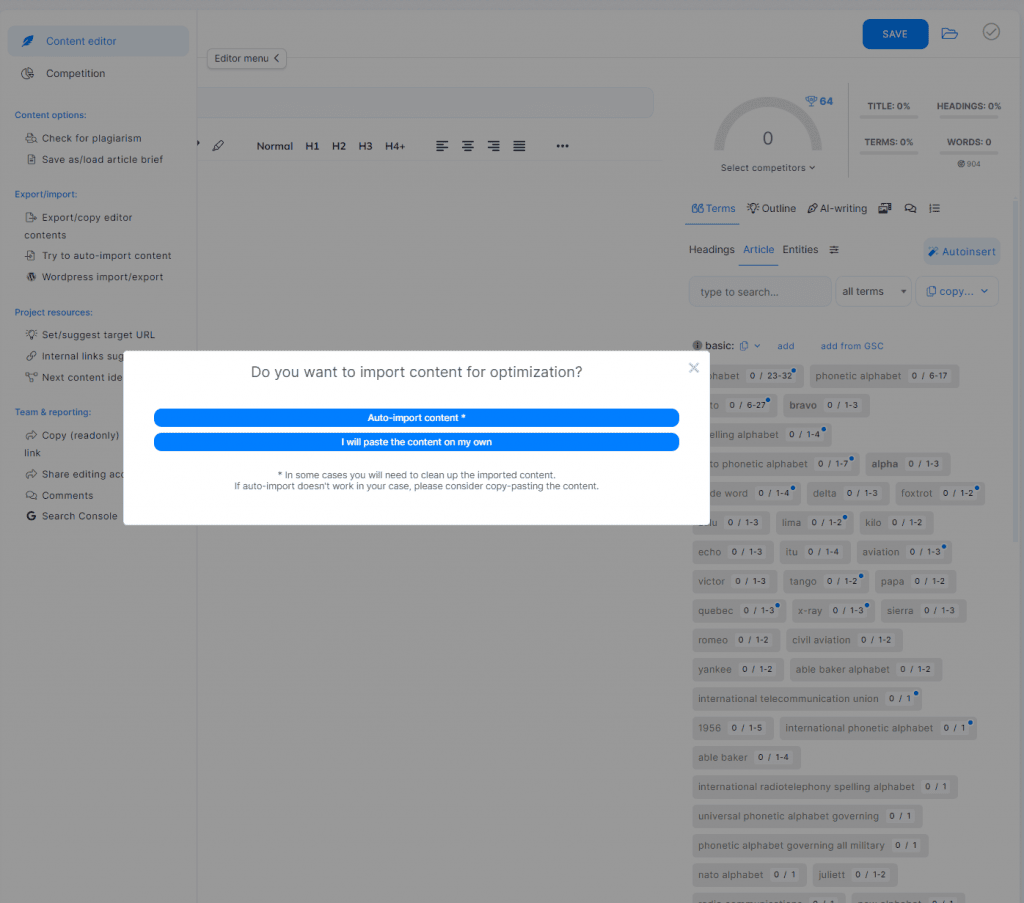
Optimising the Content for NLP
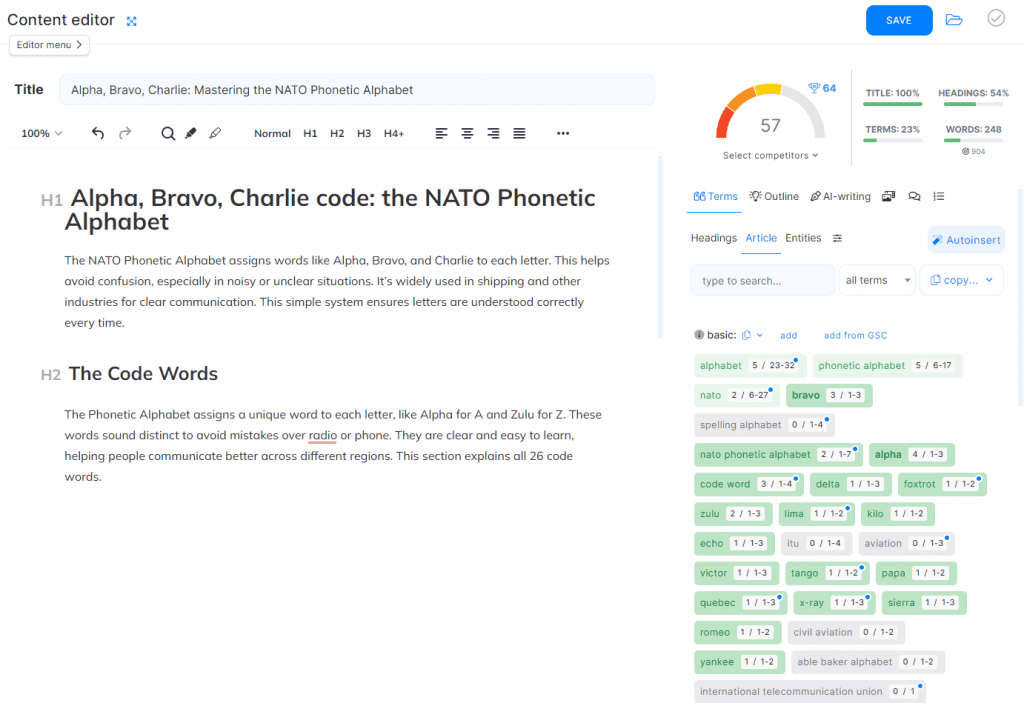
After importing the content we see a few things that gives an impressions:
The Content Article score is 57, if you hover over that score, it says the highest score of competitor is 64 and the average score in top 10 of Google is around 50. But we have oppurtunities to improve.
The list of basic terms indicates if we’ve used that particular wording. It is recommended to use if you want to optimise for NLP.
TIP: Click on the term and then click on “click to see example usage”. This gives the context as well how this term is used. so you could do something similar or better!
On the right panel click on Outline and then on Questions:
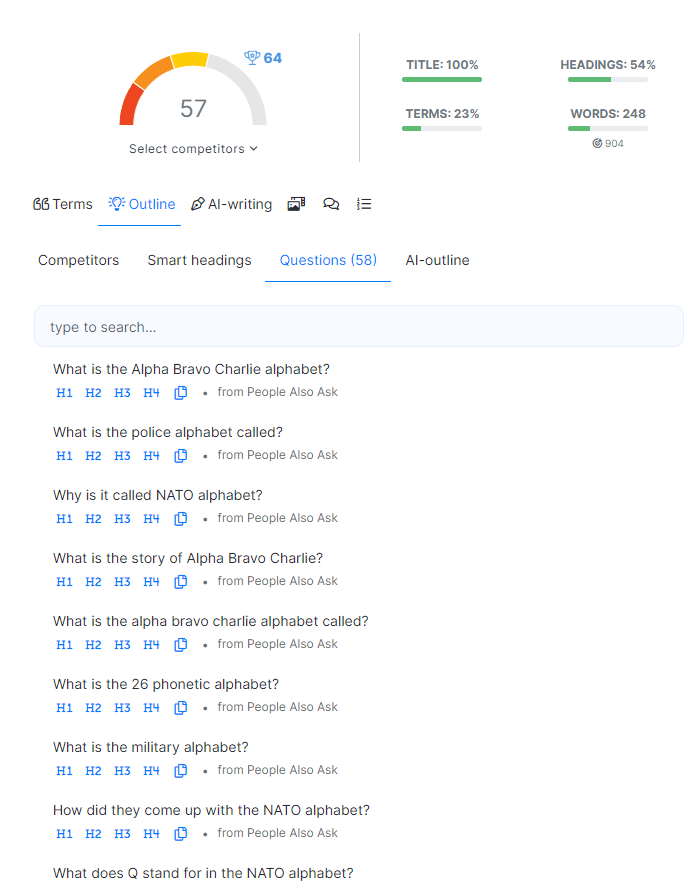
This is where you can find the People Also Ask questinos, Google Suggest Searches and competitor questions. Take questions that would be relevant to your content. Think about what your audience is looking for and if the question with answer would add value for your audience. This section is great if you are doing a questions and answers format.
Now on the right panel again we will look for the terms that should be in the title and headings to optimize the content for NLP.
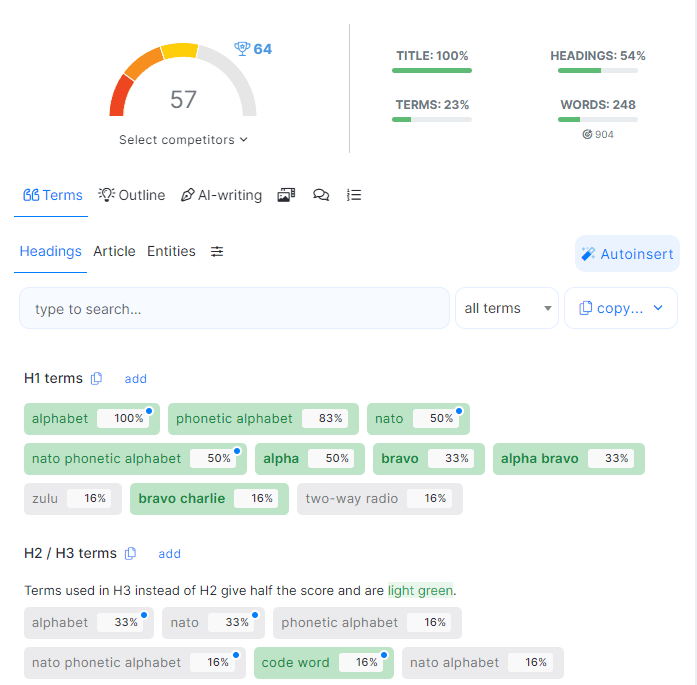
as you can see I have a good amount of opportunities, combining this with the questions and answers.
Structure your content
When optimizing your content make sure it’s structured. You essentially want to have the right information for your visittor. Make sure your text is clear and understandable.
The Blue dots at the terms, are entities. Make sure to include them if it is relevant to your article. Don’t forget to check out how the entities are used by clicking on them in NEURONwriter.
It’s important to write in a conversational tone, as this can improve engagement time with your audience. Use transition words that make the content more readable and flowing. Create content that your audience wants to read and share.
After optimization
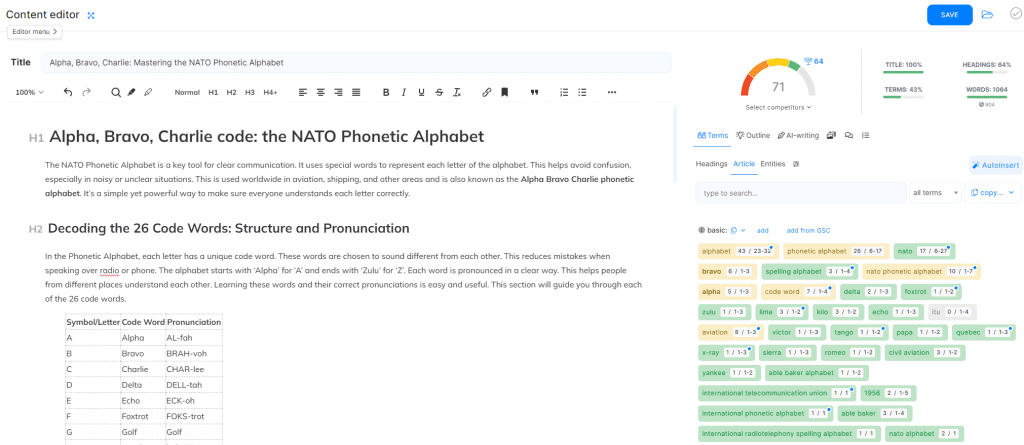
The article went from a score 57 to 71.
Using Google Search Console let’s see how this NLP SEO performed, fast forwarding so we compare 3 months and look at the results:

In 3 months time, we gained 800 extra clicks and a lot of more impressions. Just by adding relevant questions and incorporating the terms that NEURONwriter suggested. The CTR, however, remained the same. The keyword often shows up as a featured snippet in the search engine results page.
Let’s see how the queries performed as well:
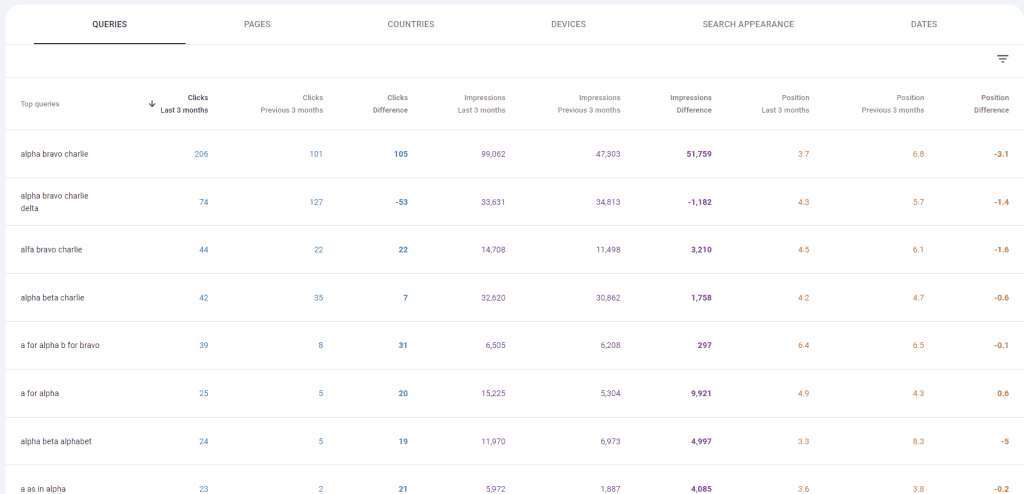
the main keyword I wanted to improve one got 51759 more impressions in a 3 months comparison. It went up from an average 6.8 to the 3.7. The amount of clicks for this keyword have doubled. Not only that, a lot of other queries got improved as well.
There are a lot of wins that in the end translates into a 800+ clicks in 3 months.
With only using a few features of NEURONwriter, and Google Search Console this content piece has been optimized.
I would recommend to revisit articles between 3-6 months.
